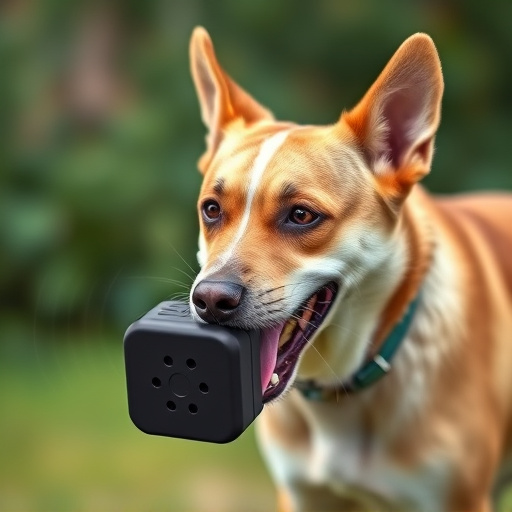“Discover a humane approach to pet deterrence with adjustable sound level devices. This comprehensive guide explores ‘Understanding Pet Deterrents: A Humane Approach’, delving into the science behind electronic repellents and their impact on your pet’s well-being. Learn about key features to look for in an adjustable sound device, including training modes that merge positive reinforcement with cutting-edge technology. We’ll also provide implementation tips and safety guidelines for effective, ethical use.”
- Understanding Pet Deterrents: A Humane Approach
- The Science Behind Electronic Repellents
- Features to Consider in an Adjustable Sound Device
- Training Modes: Positive Reinforcement Meets Technology
- Implementation and Safety Tips for Effective Use
Understanding Pet Deterrents: A Humane Approach
Pet deterrents have evolved beyond traditional, often harsh methods to embrace more humane training modes. These modern solutions focus on encouraging positive behavior change using electronic repellents that emit adjustable sound levels. By offering a gentle yet effective alternative, pet owners can train their animals without causing distress or fear.
The key advantage lies in the ability to customize the sound intensity based on the animal’s reaction and sensitivity. This precise approach ensures that the deterrent remains effective while minimizing any potential discomfort. Humane training modes not only promote better pet care but also strengthen the bond between owners and their pets by fostering open communication and understanding, all while achieving desired behavioral modifications.
The Science Behind Electronic Repellents
The science behind electronic pet deterrents revolves around using humane training modes to modify animal behavior. Unlike traditional, often harsh methods, these repellents employ gentle stimuli to guide pets away from unwanted areas. They typically emit sounds or vibrations at adjustable levels, designed to be discomforting enough to discourage persistent behavior but not painful or harmful. This approach is particularly effective for dogs, as they respond well to positive reinforcement and can learn new habits through non-punitive means.
Electronic repellents are based on the principle of operant conditioning, where pets associate certain actions with specific consequences. By adjusting sound levels, users can tailor the intensity of the deterrent to match the pet’s sensitivity and the severity of the behavior. This flexibility ensures a humane training process that respects the animal’s well-being while effectively modifying their behavior.
Features to Consider in an Adjustable Sound Device
When choosing a pet deterrent with adjustable sound levels, consider devices that offer humane training modes. These modes utilize sounds like high-frequency ultrasonics or gentle vibrations to deter pets without causing harm, promoting positive behavior modification. Electronic repellent systems are an effective and humane alternative to traditional, potentially abusive methods.
Key features include customizable sound intensity settings, allowing you to adjust the volume according to your pet’s sensitivity and the situation. This ensures a quiet environment for humans while still being effective in deterring pets. Additionally, look for devices with automatic activation options, which trigger sounds only when motion is detected, minimizing false alarms and preserving battery life.
Training Modes: Positive Reinforcement Meets Technology
Training modes in modern electronic pet deterrents often blend innovative technology with humane, positive reinforcement methods. This dual approach ensures that pets aren’t subjected to harsh or unpleasant experiences. Instead, devices are designed to emit adjustable sound levels, gradually increasing as a pet approaches a designated area. Through consistent and positive feedback, such as a beep or a gentle vibration, pets learn to associate the controlled environment with these warnings, eventually avoiding them altogether.
This method is particularly effective for teaching indoor-outdoor pets their boundaries without resorting to traditional deterrents that might cause fear or distress. By combining technology with humane training, pet owners can foster responsible behavior in their furry companions while maintaining a peaceful and positive home environment.
Implementation and Safety Tips for Effective Use
When implementing a pet deterrent with adjustable sound levels, it’s crucial to utilize humane training modes that promote positive reinforcement. Start by acclimating your pet to the device’s lowest sound level, encouraging desired behaviors without causing discomfort. Gradually increase the intensity as needed, consistently reinforcing good behavior. This approach not only ensures effective deterrence but also fosters a deeper connection between you and your pet based on trust and understanding.
Safety is paramount when using electronic repellents. Always follow manufacturer guidelines for proper placement, ensuring the device is out of reach from curious paws or noses. Regularly inspect batteries and components for wear and tear. Additionally, be mindful of environmental factors; avoid using these devices in extreme temperatures or damp conditions to prevent any potential harm to both your pet and the equipment.
In conclusion, adjustable sound level pet deterrents offer a modern, humane approach to keeping pets away from unwanted areas. By combining scientific principles with flexible training modes, these devices provide an effective and safe solution for both pets and homeowners. When used responsibly, electronic repellents can foster positive reinforcement while ensuring a peaceful coexistence between animals and their environments.
